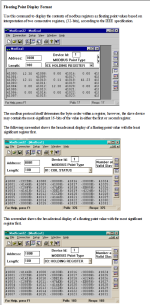Aimin Ariff
Member
Hello guys, I used modscan32 before to read data using TCPIP based on given IP Address, Device ID and etc. The data I used to read in modscan32 are just in integer. So it is fine and I can read it based on address 40001 until 40020 for all the data.
But then, when the data change to float, the reading value in modscan32 changed completely like 168392 for address 40001. And when I did floating point or swap, it combined both 40002 and 40001 with a value but the value is still not the same as the real value extract.. How can I convert the data to real numbers of float? For example, temperature of 32.67 instead of having random number in the integer in modscan32?
But then, when the data change to float, the reading value in modscan32 changed completely like 168392 for address 40001. And when I did floating point or swap, it combined both 40002 and 40001 with a value but the value is still not the same as the real value extract.. How can I convert the data to real numbers of float? For example, temperature of 32.67 instead of having random number in the integer in modscan32?








